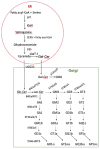The Ying and Yang of Ganglioside Function in Cancer
- PMID: 38001622
- PMCID: PMC10670608
- DOI: 10.3390/cancers15225362
The Ying and Yang of Ganglioside Function in Cancer
Abstract
The plethora of information about the expression of cancer cell-associated gangliosides, their role(s) in signal transduction, and their potential usefulness in the development of cancer treatments makes this an appropriate time to review these enigmatic glycosphingolipids. Evidence, reflecting the work of many, indicates that (1) expression of specific gangliosides, not generally found in high concentrations in most normal human cells, can be linked to certain types of cancer. (2) Gangliosides can affect the ability of cells to interact either directly or indirectly with growth factor receptors, thereby changing such things as a cell's mobility, rate of proliferation, and metastatic ability. (3) Anti-ganglioside antibodies have been tested, with some success, as potential treatments for certain cancers. (4) Cancer-associated gangliosides shed into the circulation can (a) affect immune cell responsiveness either positively or negatively, (b) be considered as diagnostic markers, and (c) be used to look for recurrence. (5) Cancer registries enable investigators to evaluate data from sufficient numbers of patients to obtain information about potential therapies. Despite advances that have been made, a discussion of possible approaches to identifying additional treatment strategies to inhibit metastasis, responsible for the majority of deaths of cancer patients, as well as for treating therapy-resistant tumors, is included.
Keywords: ganglioside; glycocalyx; growth factors; lipid rafts; multivalent oligosaccharide ligands.
Conflict of interest statement
The author declares no conflict of interest.
Figures

Similar articles
-
Gangliosides as Signaling Regulators in Cancer.Int J Mol Sci. 2021 May 11;22(10):5076. doi: 10.3390/ijms22105076. Int J Mol Sci. 2021. PMID: 34064863 Free PMC article. Review.
-
Gangliosides: glycosphingolipids essential for normal neural development and function.Trends Biochem Sci. 2015 Jul;40(7):397-406. doi: 10.1016/j.tibs.2015.03.007. Epub 2015 May 1. Trends Biochem Sci. 2015. PMID: 25941169 Review.
-
The role(s) of gangliosides in neural differentiation and repair: a perspective.Brain Res Bull. 1990 Jan;24(1):131-41. doi: 10.1016/0361-9230(90)90297-d. Brain Res Bull. 1990. PMID: 2178726 Review.
-
Gangliosides as therapeutic targets for cancer.BioDrugs. 2003;17(3):155-67. doi: 10.2165/00063030-200317030-00002. BioDrugs. 2003. PMID: 12749752 Review.
-
Recent advances in identifying the functions of gangliosides.Chem Phys Lipids. 1986 Dec 15;42(1-3):137-51. doi: 10.1016/0009-3084(86)90049-6. Chem Phys Lipids. 1986. PMID: 3030576 Review.
Cited by
-
Sphingolipids: Less Enigmatic but Still Many Questions about the Role(s) of Ceramide in the Synthesis/Function of the Ganglioside Class of Glycosphingolipids.Int J Mol Sci. 2024 Jun 7;25(12):6312. doi: 10.3390/ijms25126312. Int J Mol Sci. 2024. PMID: 38928016 Free PMC article. Review.
-
Organometallic Half-Sandwich Complexes of 8-Hydroxyquinoline-Derived Mannich Bases with Enhanced Solubility: Targeting Multidrug Resistant Cancer.Inorg Chem. 2024 Dec 16;63(50):23983-23998. doi: 10.1021/acs.inorgchem.4c04398. Epub 2024 Dec 5. Inorg Chem. 2024. PMID: 39638428 Free PMC article.
-
Oncolytic Viruses and Immunotherapy for the Treatment of Uveal Melanoma and Retinoblastoma: The Current Landscape and Novel Advances.Biomedicines. 2025 Jan 6;13(1):108. doi: 10.3390/biomedicines13010108. Biomedicines. 2025. PMID: 39857692 Free PMC article. Review.
-
Mechanistic and Therapeutic Implications of Protein and Lipid Sialylation in Human Diseases.Int J Mol Sci. 2024 Nov 7;25(22):11962. doi: 10.3390/ijms252211962. Int J Mol Sci. 2024. PMID: 39596031 Free PMC article. Review.
-
Capillary Electrophoresis-Laser Induced Fluorescence Method Development and Validation for Quantification of Nine Gangliosides-Application to Analysis of Cell Lines of CNS Origin.Molecules. 2024 Aug 9;29(16):3769. doi: 10.3390/molecules29163769. Molecules. 2024. PMID: 39202849 Free PMC article.
References
-
- Martínez-Palomo A. The Surface Coats of Animal Cells. Part of the Personal Work Mentioned in This Review Was Performed at the Institut de Recherches Scientifiques Sur Le Cancer, Villejuif, France. In: Bourne G.H., Danielli J.F., Jeon K.W., editors. International Review of Cytology. Volume 29. Academic Press; Cambridge, MA, USA: 1970. pp. 29–75. - DOI
-
- Luft J.H. Fine Structures of Capillary and Endocapillary Layer as Revealed by Ruthenium Red. FASEB J. 1966;25:1773–1783. - PubMed
-
- Thudichum J.L.W. A Treatise on the Chemical Constitution of the Brain: Based throughout upon Original Researches. Bailliere, Tindall, and Cox; London, UK: 1884.
Publication types
LinkOut - more resources
Full Text Sources

